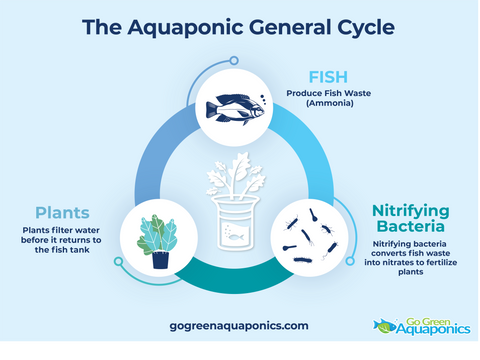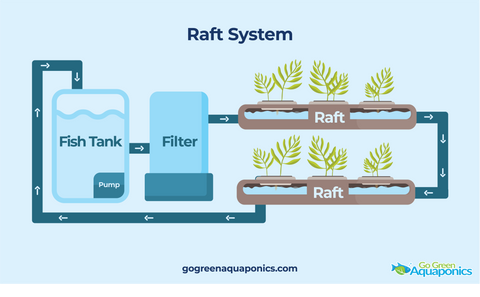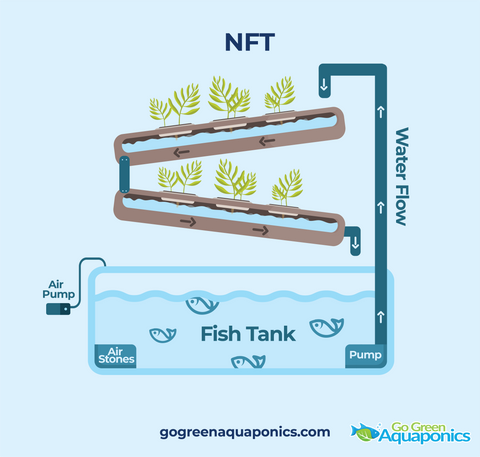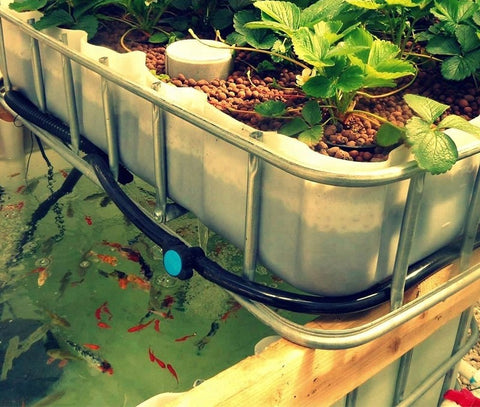Dreaming of fresh, homegrown vegetables and healthy fish? Look no further than the fascinating world of organic aquaponics! This innovative method combines aquaculture (raising fish) with hydroponics (growing plants without soil) to create a closed-loop ecosystem. Not only is it a sustainable way to produce delicious food, but it's also surprisingly beginner-friendly.
In this blog, we will walk you through every step of setting up your own organic aquaponics garden. From choosing the right fish and plants to maintaining a healthy system, we will equip you with the knowledge and confidence to cultivate your own thriving oasis. So get ready to experience the magic of organic aquaponics gardening!
Understanding Aquaponics
Aquaponics operates on the principle of nutrient cycling. In a typical aquaponics system, fish are raised in a tank, where they produce waste as ammonia through respiration and excretion. The beneficial bacteria, primarily Nitrosomonas and Nitrobacter, convert the toxic ammonia into nitrites and then nitrates, which serve as essential nutrients for plant growth.
The plants, grown in a soilless medium such as gravel or clay pellets within grow beds, absorb these nutrients, effectively filtering the water and returning it clean to the fish tank. This symbiotic relationship forms the backbone of the aquaponics system which ensures the health and vitality of both aquatic and plant life.

Here's how the aquaponics work:
- Fish do their thing: Fish, like any living creature, produce waste. In a traditional setup, this waste would need to be removed and disposed of. But in aquaponics, it becomes a valuable source of nutrients for the plants.
- Nature's filtration team: The rich in ammonia fish waste is converted by the beneficial bacteria into nitrites and then nitrates.
- A feast for plants: These nitrates as fertilizer for plant growth! Plants absorb these nutrients through their roots, thriving in a nutrient-rich water environment.
- Clean water for fish: The plants act as natural filters. Cleanse the water by absorbing the nutrients from the fish waste. This purified water is then cycled back to the fish tank, creating a healthy environment for your finned friends.
Benefits of Organic Aquaponics Gardening
There are many reasons to fall in love with organic aquaponics gardening. Here are just a few:
- Fresh, Homegrown Food: Enjoy the satisfaction of harvesting healthy, delicious vegetables and herbs grown in your own organic system. You'll know exactly what goes into your food, free from harmful chemicals and pesticides.
- Sustainable Gardening: Aquaponics is a champion of sustainability. It conserves water by recirculating it in a closed loop, using up to 90% less water compared to traditional gardening. Plus, you eliminate the need for chemical fertilizers, reducing your environmental footprint.
- Year-Round Gardening: Unlike traditional gardens limited by seasons, aquaponics allows you to grow food indoors year-round. This is especially beneficial in regions with harsh climates.
- Space-Saving Efficiency: Aquaponics makes the most of your space. By stacking the fish tank and grow beds vertically, you can cultivate a thriving garden even in a small area, perfect for balconies or urban settings.
- Low Maintenance: Aquaponics is surprisingly low maintenance once established. The balanced ecosystem takes care of itself, requiring less weeding and pest control compared to traditional gardens.
Planning Your Organic Aquaponics System
Now that you’ve learned the basic of aquaponics, let's get down to the planning stage. Before diving headfirst into buying supplies, consider these key elements:
A. Choosing a System Design
The first step is selecting the type of aquaponics system that best suits your space and gardening goals. Here are the three most common designs:

1. Media-Based System: This is the most popular choice for beginners. It features a grow bed filled with a media like gravel or clay pebbles, where plants root and beneficial bacteria thrive. Water from the fish tank is periodically flooded into the grow bed, allowing plants to access nutrients and the media to filter the water. This system is relatively simple to set up and requires minimal maintenance.

2. Raft System (Deep Water Culture): Often used in commercial applications, this design features a constant water level in the fish tank. Plants are suspended on floating rafts with their roots dangling directly in the nutrient-rich water. This system is highly productive but requires good water circulation and oxygenation to keep plant roots healthy.

3. Nutrient Film Technique (NFT): This space-saving system utilizes sloped channels or gutters filled with a thin film of water that constantly flows past the plant roots. Ideal for leafy greens, NFT systems require a reliable pump and precise water level management.
Factors to consider when choosing your system:
- Available Space: Media beds are generally the most space-efficient option for beginners.
- Experience Level: Media beds and raft systems are easier to manage for beginners, while NFT requires more technical expertise.
- Desired Plants: Some plants, like leafy greens, thrive in NFT, while others, like herbs, prefer media beds.
B. Selecting the Right Fish
Here's what to keep in mind when choosing your finned friends:
- Ammonia Production: Opt for fish with a moderate ammonia output, like tilapia or goldfish. These species create a steady stream of nutrients for your plants without overloading the system.
- Hardiness: Choose fish that is known for their resilience, such as goldfish or koi. These can tolerate fluctuations in water quality that might occur during the initial setup phase.
- Stocking Density: Don't overcrowd your fish tank. Research the appropriate stocking density for your chosen fish species and tank size. Overcrowding can lead to poor water quality and fish health problems.
C. Choosing Plants to Grow
When choosing plants, consider these factors:
- Nutrient Needs: Plants have varying nutrient requirements. Leafy greens like lettuce and kale generally thrive in aquaponics systems.
- Beginner-Friendly Options: Opt for plants with a forgiving nature, like lettuce, basil, and herbs. These are easier to cultivate for beginner aquaponic gardeners.
- Root System Compatibility: Plants with well-aerated root systems, like those that thrive in hydroponics, are ideal for aquaponics.
Here are some excellent beginner-friendly plant choices for your organic aquaponics system:
- Leafy Greens such as lettuce, kale, spinach an other leafy greens.
- Herbs such as basil, mint, chives
- Other Options such as tomatoes, strawberries and other fruiting plants, and flowers and other ornamental plants.
Setting Up Your Organic Aquaponics System
With your plan in place, it's time to roll up your sleeves and get your organic aquaponics system up and running! Here's a breakdown of the essential components and their setup:
1. Fish Tank
The fish tank serves as the heart of your aquaponics system that housing your fish and other aquatic animals.
- Size: The size of your fish tank will depend on the type of fish you choose, the number of plants you plan to grow, and your available space. A good rule of thumb is to allow 1 gallon of water per inch of mature fish.
- Filtration: While beneficial bacteria will handle most of the filtration, a filter is still recommended to remove solid waste and debris from the water.
- Aeration: Proper oxygen levels are crucial for both fish and the beneficial bacteria. An air pump and airstone will ensure adequate oxygen circulation within the tank.
2. Grow Bed
The grow bed is the haven for your plants, providing a platform for them to root and access the nutrient-rich water.
- Media Selection: Choose a media that offers good drainage, aeration, and support for plant roots. Popular options include expanded clay pebbles, gravel, or coco coir.
- Support Structure: The grow bed can be a simple container made of plastic, wood, or even food-grade tote bins. Ensure it's sturdy enough to hold the weight of the media and water, and has drainage holes to prevent waterlogging.
3. Plumbing Considerations (water flow, pump selection)
The plumbing system is the lifeline of your aquaponics setup that ensure the continuous flow of water between the fish tank and the grow bed.
- Water Flow: You can choose between flood and drain systems (where the grow bed is periodically flooded and then drained) or continuous flow systems (where water constantly circulates through the grow bed).
- Pump Selection: The pump you choose will depend on the size of your system and the desired water flow rate.
Here are some additional tips for setting up your aquaponics system:
- Don't forget the lid! A lid on your fish tank helps prevent water evaporation and minimizes the risk of fish jumping out.
- Lighting is key! Depending on the type of plants you choose, you might need to supplement with artificial lights, especially if your system is indoors.
- Test and monitor! Regularly test your water quality for pH, ammonia, nitrites, and nitrates. This helps ensure a healthy environment for both fish and plants.

The Cycling Process: Establishing a Balanced System
Before introducing fish and plants to your brand new aquaponics system, there's a vital step you can't skip: cycling your system. This process involves establishing a healthy population of beneficial bacteria that break down fish waste into usable nutrients for your plants. Think of it as creating a balanced mini-ecosystem within your system.
A. The Role of Beneficial Bacteria:
These microscopic heroes are the workhorses of your aquaponics system. There are two main types:
- Nitrosomonas bacteria: These guys convert harmful ammonia, produced by fish waste, into nitrites.
- Nitrobacter bacteria: They take over from their nitrosomonas colleagues, further converting the nitrites into nitrates, a valuable nutrient for your plants.
B. Fishless vs. Fish-in Cycling Methods:
There are two main approaches to cycling your aquaponics system:
1. Fishless Cycling (Recommended): This humane method prioritizes the well-being of your fish. Here's what you do:- Add an ammonia source, like pure ammonia solution or fish food, to the fish tank.
- Monitor the water quality regularly, tracking the rise and fall of ammonia, nitrites, and finally, nitrates.
- Once the ammonia and nitrites have reached zero, and the nitrates are at a stable level (around 20-40 ppm), your system is cycled and ready for fish and plants.
Here's why fishless cycling is generally preferred:
- Safer for Fish: Avoids exposing fish to potentially harmful ammonia and nitrite spikes during the cycling process.
- More Control: Allows you to precisely control the ammonia levels, ensuring optimal growth for the beneficial bacteria.
- Faster Cycling: Fishless cycling can often be completed quicker than fish-in cycling.
Planting and Maintaining YourOrganic Aquaponics Garden
A. Selecting and Starting Plants
Choosing the right plants sets the stage for a thriving aquaponics oasis. Here's what to consider:
- Plant Selection: Remember, leafy greens like lettuce and kale, herbs like basil, and some fruiting options like cherry tomatoes are excellent choices for beginners.
- Seeds vs. Seedlings: Starting with seedlings is generally easier for beginners, as they require less care and have a higher success rate. However, seeds offer a wider variety and the satisfaction of watching them grow from scratch.
- Proper Spacing: Don't crowd your plants! Research the mature size of your chosen plants and space them appropriately in the grow bed to ensure proper airflow and access to nutrients.
B. Planting Tips
- Germinate seeds: Follow best practices for seed germination in a separate tray before transplanting healthy seedlings into the grow bed.
- Prepare the grow media: Moisten the media in the grow bed to create a hospitable environment for your plants.
- Plant carefully: Gently plant your seedlings or seeds at the appropriate depth, following plant-specific recommendations.
C. Monitoring Water Quality
Regular water quality monitoring is crucial for maintaining a healthy balance in your aquaponics system. Here are the key parameters to track:
- pH: Aim for a neutral pH level (between 6.5 and 7.5) for optimal plant and fish health.
- Ammonia: During the initial cycling process, ammonia should be steadily converted by the bacteria. Once established, ammonia levels should ideally be undetectable.
- Nitrites: Similar to ammonia, nitrites should also be undetectable in a well-cycled system.
- Nitrates: Nitrates are the preferred form of nitrogen for your plants. Maintain a nitrate level between 20-40 ppm for optimal plant growth.
Monitoring Tips:
- Invest in a reliable water testing kit to easily measure these key parameters.
- Test your water quality regularly, at least once a week, to identify any potential issues early on.
- Based on your test results, take corrective actions to maintain the desired water quality.
D. Organic Plant Care
Organic aquaponics allows you to cultivate healthy food free from harmful chemicals. Here's how to care for your plants organically:
- Natural Pest Control: Encourage beneficial insects like ladybugs and praying mantises to help control common pests organically. You can also use insecticidal soap or neem oil for targeted pest control.
- Supplemental Nutrients: While the fish waste provides most nutrients, your plants might occasionally require additional minerals like calcium or magnesium. Use organic fertilizer supplements specifically formulated for aquaponics.
Additional Maintenance Tips:
- Observe your plants: Regularly inspect your plants for signs of disease or nutrient deficiencies. Address any issues promptly to maintain healthy growth.
- Prune strategically: Pruning encourages bushier growth and can help improve air circulation around your plants.
- Harvest with joy: Once your plants reach maturity, enjoy the fruits (or vegetables) of your labor!
Harvesting Your Aquaponics Garden
This section will guide you through harvesting techniques, essential maintenance practices, and tips for troubleshooting common problems.
A. Harvesting Techniques for Different Plants
The harvesting approach depends on the type of plants you're growing:
- Leafy Greens: Harvest outer leaves regularly to encourage new growth. Use sharp scissors or a knife to carefully cut the leaves at the base.
- Herbs: Harvest leaves as needed throughout the growing season. Pinch off individual leaves or trim stems for larger quantities.
- Fruiting Plants: Allow fruits to ripen fully on the vine before harvesting. Gently twist or cut the fruit from the stem, leaving a small nub attached to the plant.
Harvesting Tips:
- Harvest early in the morning when temperatures are cooler and plants are well-hydrated.
- Disinfect your harvesting tools before and after use to prevent the spread of disease.
- Avoid overharvesting! Leave enough foliage on your plants to ensure continued growth.
B. Troubleshooting Common Problems
Even the most diligent aquaponic gardener might encounter occasional challenges. Here's how to tackle some common issues:
- Algae Growth: Excessive light or nutrient imbalance can lead to algae growth. Reduce light exposure or adjust your feeding schedule.
- Slow Plant Growth: Nutrient deficiency, low water temperature, or root rot can hinder growth. Test your water quality, adjust temperature if needed, and ensure proper aeration.
- Fish Illness: Maintain good water quality and observe your fish for signs of illness. Quarantine sick fish and treat with appropriate organic remedies if necessary.
Conclusion
We hope this blog has equipped you with the knowledge and confidence to embark on your own aquaponics adventure. Remember, aquaponics is a journey of exploration and learning. Embrace the challenges, celebrate the successes, and enjoy the satisfaction of cultivating your own organic food source. With dedication and these handy tips, you'll be well on your way to becoming a master aquaponic gardener!






Joseph Johnson
February 14, 2023
Interested in learning about aquaponics for home use